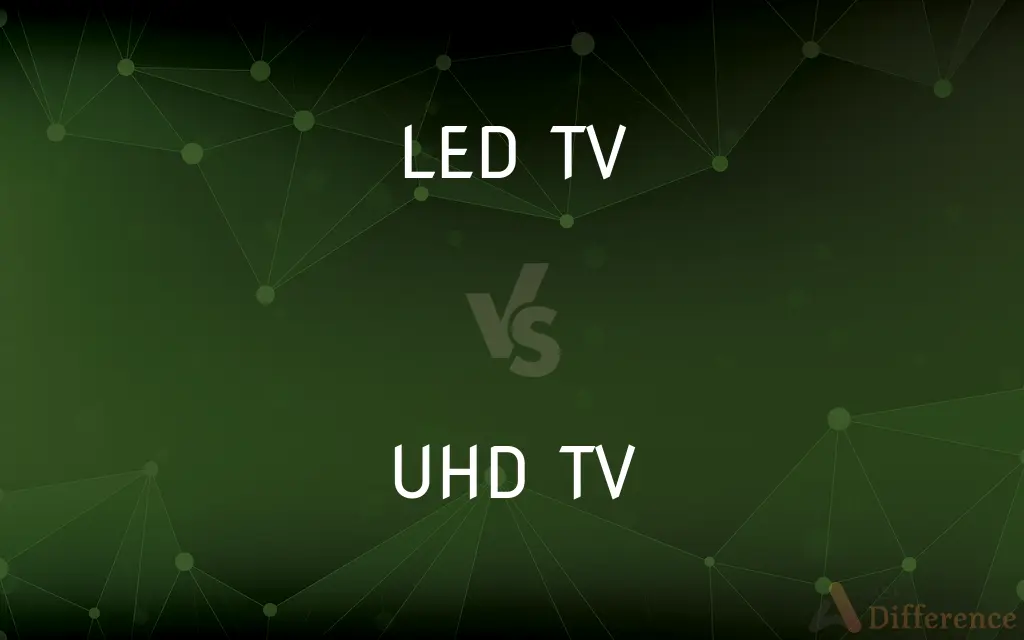LED TV vs. UHD TV — What's the Difference?
Edited by Tayyaba Rehman — By Fiza Rafique — Published on December 16, 2023
LED TV uses light-emitting diodes for backlighting, while UHD TV refers to a screen resolution of 3840x2160 pixels, offering 4K clarity.

Difference Between LED TV and UHD TV
Table of Contents
ADVERTISEMENT
Key Differences
LED TV specifically references the technology that lights up the screen, which are light-emitting diodes. UHD TV, on the other hand, indicates the screen's resolution, which stands for Ultra High Definition. While an LED TV can be UHD if it has the required resolution, not all LED TVs will necessarily be UHD. UHD TV aims to provide viewers with a more detailed and sharper image, boasting a resolution four times higher than standard Full HD.
However, LED TV focuses more on the quality of lighting and contrast, ensuring that images are illuminated evenly and efficiently. It's worth noting that advancements in television technology have led to many LED TVs being manufactured with UHD capabilities. Still, when discussing LED TV and UHD TV, the former refers to backlighting technology while the latter highlights resolution.
Comparison Chart
Primary Feature
Backlighting technology.
Screen resolution.
Definition
Uses light-emitting diodes for illumination.
Offers a resolution of 3840x2160 pixels.
Clarity/Resolution
Varies (can be SD, HD, Full HD, or UHD).
Always 4K clarity.
ADVERTISEMENT
Technology Type
Refers to the lighting source.
Refers to image quality based on pixel count.
Common Usage in Marketing
To emphasize screen brightness and contrast.
To emphasize clarity, sharpness, and detailed picture quality.
Compare with Definitions
LED TV
A television with longer lifespan due to LED backlighting.
Our LED TV has lasted for over 7 years without any issues.
UHD TV
A television with a screen resolution of 3840x2160 pixels.
The UHD TV displayed breathtaking details in the movie.
LED TV
An alternative to older LCD TVs that used CCFL backlighting.
We upgraded from our old LCD to a new LED TV.
UHD TV
Often paired with advanced features like HDR for enhanced viewing experience.
The UHD TV we bought also supports HDR, making colors pop.
LED TV
A television that often boasts a slimmer design because of its lighting technology.
The slim profile of our LED TV fits perfectly on our wall.
UHD TV
Best suited for larger screens to fully appreciate the higher resolution.
Our 65-inch UHD TV is the centerpiece of our home theater.
LED TV
A TV distinguished by its energy-efficient backlighting system.
We chose an LED TV to reduce our energy bills.
UHD TV
Also known as 4K TV, offering four times the resolution of Full HD.
We watched the documentary on a UHD TV and were amazed by the clarity.
LED TV
A television that uses light-emitting diodes for screen illumination.
The LED TV provides vibrant colors and good contrast.
UHD TV
A television that provides superior sharpness and detail in images.
The soccer match looked incredibly real on our UHD TV.
Common Curiosities
What does LED in LED TV stand for?
LED stands for Light Emitting Diodes, which illuminate the screen.
Why would someone choose an LED TV?
LED TVs are energy-efficient, have a longer lifespan, and often a slimmer design.
Can an LED TV also be a UHD TV?
Yes, an LED TV can have UHD resolution, but not all LED TVs are UHD.
How does UHD TV differ from Full HD?
UHD TV offers four times the resolution of Full HD.
What is the main characteristic of a UHD TV?
UHD TV boasts a resolution of 3840x2160 pixels, providing 4K clarity.
Do larger screens benefit more from UHD TV resolution?
Yes, the increased resolution of UHD TV is often more noticeable on larger screens.
Which provides better image clarity: LED TV or UHD TV?
UHD TV refers to image clarity based on pixel count, so it would provide better sharpness.
Are all UHD TVs also LED TVs?
No, but many modern UHD TVs use LED backlighting.
Is OLED the same as LED in LED TV?
No, OLED (Organic Light Emitting Diodes) is a different technology where each pixel emits its own light.
How does UHD TV enhance the movie-watching experience?
UHD TV offers sharper, clearer, and more detailed visuals, enhancing the overall viewing experience.
If I buy a UHD TV, do I need special content to enjoy its benefits?
For optimal benefits, it's best to watch content produced in 4K or UHD, though these TVs often upscale lower-resolution content.
How do LED TVs produce images?
LED TVs use diodes to backlight an LCD screen, producing the visible image.
Is there a noticeable difference between LED TV and UHD TV when watching standard broadcasts?
While LED affects brightness and contrast, UHD's increased resolution might not be fully utilized in standard broadcasts.
Does LED TV consume less power?
Yes, LED TVs are generally more energy-efficient compared to older LCD TVs with CCFL backlighting.
What other features often accompany UHD TVs?
UHD TVs often come with features like HDR, enhanced color technologies, and higher refresh rates.
Share Your Discovery

Previous Comparison
Maharashtra vs. Andhra Pradesh
Next Comparison
Native Speaker vs. FluentAuthor Spotlight
Written by
Fiza RafiqueFiza Rafique is a skilled content writer at AskDifference.com, where she meticulously refines and enhances written pieces. Drawing from her vast editorial expertise, Fiza ensures clarity, accuracy, and precision in every article. Passionate about language, she continually seeks to elevate the quality of content for readers worldwide.
Edited by
Tayyaba RehmanTayyaba Rehman is a distinguished writer, currently serving as a primary contributor to askdifference.com. As a researcher in semantics and etymology, Tayyaba's passion for the complexity of languages and their distinctions has found a perfect home on the platform. Tayyaba delves into the intricacies of language, distinguishing between commonly confused words and phrases, thereby providing clarity for readers worldwide.
















































